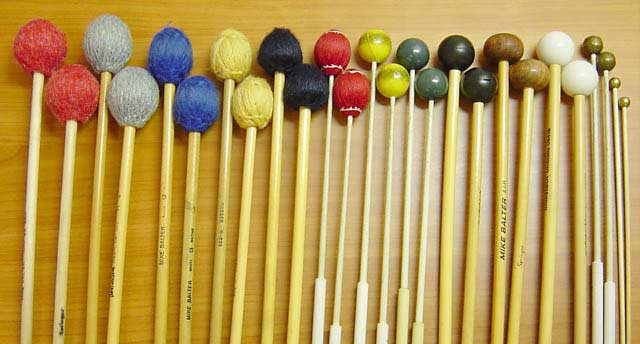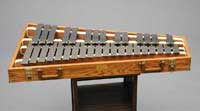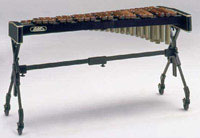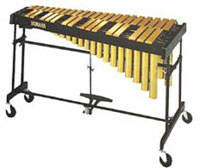For non-percussionists
A guide to the mallet instruments
Matt Springer, 11/05
Are you mystified about what these percussion instruments are? Even if you don't recognize some of the names, you've heard them all before. Here is a quick tutorial.
The four main mallet percussion instruments, also known as keyboard percussion instruments, are the glockenspiel, xylophone, marimba, and vibraphone. They are all played by using mallets to strike bars in the pattern of a piano keyboard, but they differ in their size, tonal range, material (metal or wood/fiberglass), and resonators (hollow tubes below the bars that amplify the tone).
I have put some representative sound clips on this site (best with a fast connection); you may need to download the free Quicktime player for Mac or Windows. In addition, you can hear examples of these four instruments played together by checking out the streaming audio of my two published mallet percussion ensemble arrangements at their respective information pages:
Four Pieces from the Gayane Ballet Suite (by Aram Khachaturian)
Three Grieg Dances (music of Edvard Grieg)
| Glockenspiel (orchestra bells): Not to be confused with the lyre-shaped glockenspiels of old-fashioned marching bands, which are held vertically in one hand and played with the other hand using a single mallet, the 2- to 3-octave glockenspiel used in orchestras and in modern marching bands and drum & bugle corps is played horizontally like the other mallet instruments. The bars are made out of steel or aluminum, usually do not have resonators, and are typically played with metal or plastic mallets. The sound is a pure, high bell tone (this instrument sounds two octaves higher than written in most cases). The glockenspiel figures prominently in The Sorcerer's Apprentice by Dukas, and numerous other orchestral pieces. | |
| Xylophone (pronounced "zylophone"): This 3- to 4- octave instrument uses wood or fiberglass bars with very short resonators, emphasizing the mallet hit but with no lasting resonance afterwards. The sound is a high-pitched wooden "clink" sound when played with plastic or wood mallets (one octave higher than written in most cases), with a slightly more mellow sound when played with rubber mallets. Gershwin's "Porgy and Bess" and several Copland pieces have famous xylophone parts, and the instrument's more comical side is responsible for the Bugs Bunny theme. It is also well-suited for ragtime music. | |
Marimba: The marimba looks very similar to the xylophone, with wooden or fiberglass bars, but the bars are longer and lower-pitched, and the resonators are much longer, giving the tone a long-lasting and beautiful resonance. It is usually played with yarn-wound mallets, although rubber mallets are sometimes used, and the low notes can go as low as an octave and a half below middle C, making this the lowest mallet instrument (bass marimbas also exist, with incredibly low tones and resonators that go all the way to the ground and curve back up again). It is usually a bit over 4 octaves. The modern marimba is based on African and Latin American instruments of the same name, and when a two-note interval is rolled, it results in a very recognizable Mexican sound. The marimba only started appearing in western orchestral music in the later 20th Century, and solo/ensemble pieces for marimba are growing at an explosive pace. It also has been used frequently in jazz and pop music (from Starbuck to Frank Zappa). For some reason, it is ideally suited for the music of Bach, and I have stated before that Bach would have written for the marimba had he only known of its existence. |
Audio excerpts: |
| Vibraphone: The vibraphone has metal keys, but unlike the glockenspiel, the notes are tuned in a middle range and have resonators similar to those of the marimba, making it a more melodious instrument. It is normally played with yarn-wound mallets. The vibraphone gets its name from its unique quality of having an electric motor continuously opening and closing the tops of the resonators, giving it a haunting vibrato when the motor is turned on. Despite this, the vibraphone is most often played without the motors, resulting in a pure tone. This instrument is also unique in that it has a pedal that, when pressed with the foot, allows the tone to resonate for several seconds after the bar is hit. When the pedal is released, a spring-loaded felt pad presses against the bars, stopping the tone. Also known as the vibes, this instrument has been a mainstay in big band jazz for decades (Lionel Hampton was a well-known jazz vibes player). It figures prominently in "Cool" and "Maria" from West Side Story, is sometimes used in late 20th Century orchestral music, and is a lovely solo instrument as well. For an eerie special effect, the bars can be bowed with a well-rosined bass bow. |
| Two other related instruments, not used in my own arrangements, are the crotales, which are metal discs arranged in a keyboard orientation that have a very space-age sound, and the familiar chimes, which are not technically a mallet keyboard instrument but consist of long hung metal tubes in a keyboard orientation, hit on the top with hammers. |
| The mallets: The sound also depends greatly on the kind of mallet used to hit the bar, whether it is made of metal, wood, plastic, or rubber, and whether the material is bare or wound with yarn or cord. The instruments can be played with one mallet in each hand but are frequently played with two mallets in each hand, gripped in such a way that each mallet can move independently and four notes can be played at a time. Some pieces even call for three mallets in each hand! |
 |
If you encounter any problems or inaccuracies on this site, please e-mail me.



